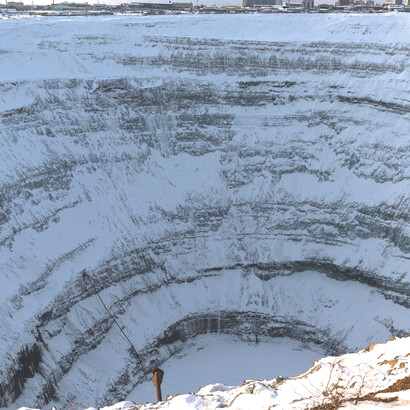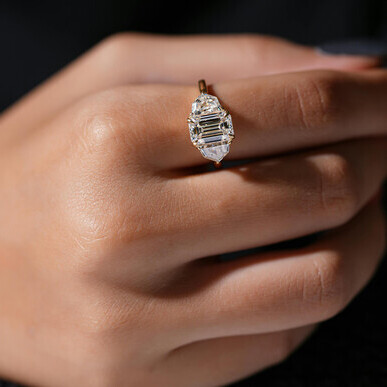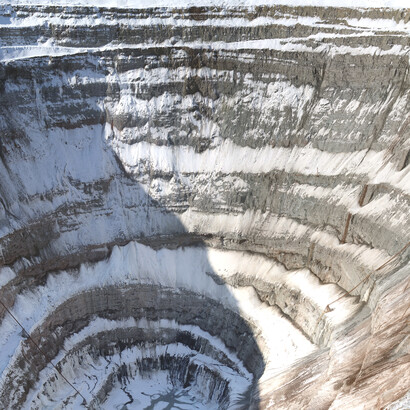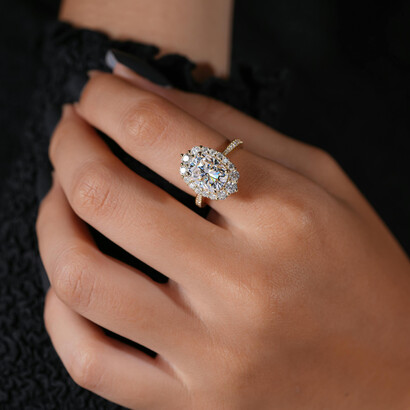Lab-grown diamonds are real diamonds, chemically and physically identical to mined diamonds, but created in a laboratory. They offer significant advantages in affordability, ethical sourcing, and environmental sustainability, typically costing 60-90% less than natural diamonds.
The choice between lab-grown and natural diamonds depends on your personal priorities: if you value cost-effectiveness and ethics, a lab-grown diamond is an excellent choice; if you prioritize tradition, perceived rarity, and potential long-term value, a natural diamond may be more suitable.
Lab-grown vs. natural diamonds
Origin & formation
Lab-grown diamonds: created in controlled laboratory environments using either HPHT (High Pressure High Temperature) or CVD (Chemical Vapor Deposition) processes. Their formation typically takes several weeks to a few months.
Natural Diamonds: formed naturally over a period of 1 to 3.5 billion years under intense heat and pressure deep within the Earth’s mantle.
Chemical & Physical Properties
Lab-grown diamonds: identical to natural diamonds, composed of pure carbon arranged in a crystalline structure, with a hardness of 10 on the Mohs scale.
Natural diamonds: also made of pure carbon in a crystalline structure, with the same hardness rating of 10 on the Mohs scale.
Appearance
Lab-grown diamonds: indistinguishable from natural diamonds to the naked eye. Only specialized equipment can tell the difference.
Natural diamonds: visually identical to lab-grown diamonds when viewed without professional instruments.
Cost & value
Lab-grown diamonds: significantly more affordable, typically costing 60–90% less than comparable natural diamonds.
Natural Diamonds: More expensive due to perceived rarity, high mining costs, and a tightly controlled market supply.
Investment & resale value
Lab-grown diamonds: currently have very low or no resale value, as the market is new and prices continue to drop.
Natural diamonds: traditionally hold better resale value, though still often lower than the original retail price.
Environmental impact
Lab-grown diamonds: generally have a lower environmental footprint, requiring less land disruption and producing less mineral waste—though the process is energy-intensive.
Natural diamonds: have a significant impact through land degradation, habitat destruction, high water usage, and mineral waste generation.
Ethical & social considerations
Lab-grown diamonds: marketed as a conflict-free and ethically sourced alternative, avoiding the issues associated with “blood diamonds.”
Natural diamonds: The mining industry has been linked to human rights abuses and poor labor conditions. Although the Kimberley Process exists to regulate conflict diamonds, it has notable limitations.
Market perception
Lab-grown diamonds: gaining popularity, especially among younger consumers who value affordability, ethics, and sustainability.
Natural diamonds: still maintain a strong position as the traditional symbol of luxury, rarity, and enduring love.
The illusion of rarity: how De Beers shaped the diamond market
De Beers' monopoly on diamond distribution
The perception of diamonds as exceedingly rare and precious gems is a narrative that has been carefully cultivated over the course of more than a century. Still, it stands in stark contrast to their actual geological abundance. While gem-quality diamonds are not as common as everyday stones, they are not as scarce as the market would suggest.
The true rarity of diamonds is not in their existence but in their controlled release into the market. This control has been the cornerstone of a powerful marketing and supply chain strategy that has defined the modern diamond industry. The value of a diamond is not solely determined by its physical properties or its natural scarcity but by a carefully managed illusion of rarity. This illusion has been so effective that it has become deeply embedded in cultural norms and consumer expectations, particularly in the context of engagement and marriage.
The reality is that the supply of diamonds has been artificially restricted for decades, creating a market where prices are kept high not by natural scarcity but by a monopoly that dictates the flow of goods. This manipulation of supply has been the key to maintaining the high perceived value of diamonds, transforming them from a beautiful but relatively common gemstone into a symbol of ultimate luxury and commitment. For much of the 20th century, De Beers held a near-total monopoly over the global diamond trade, controlling not only the mining of diamonds but also their distribution and marketing.
This monopoly was established in the late 1800s by Cecil Rhodes, who began by consolidating smaller diamond mines in South Africa. By the early 1900s, De Beers controlled over 90% of the world's diamond production, a position it maintained for decades. This level of control allowed the company to dictate the price of diamonds by carefully managing the supply. When demand was low, De Beers would simply reduce the amount of diamonds released to the market, creating an artificial scarcity that kept prices high. This strategy was so effective that it became the cornerstone of the company's business model, and it is the primary reason why diamonds have become so expensive.
The "A diamond is forever" campaign
The "A Diamond is Forever" campaign, launched by De Beers in 1947, is widely regarded as one of the most successful marketing campaigns of all time. The genius of the campaign was its ability to create a powerful and enduring emotional connection between diamonds and the concept of eternal love.
The campaign was so successful that it transformed the diamond engagement ring from a simple piece of jewelry into a cultural icon. Before this campaign, diamond engagement rings were not a universal tradition, and diamonds were not necessarily the gemstone of choice for such a significant occasion.
The campaign's message was clear: if you truly love someone, you will prove it by giving them a diamond. The campaign's success was also due to its ability to create a sense of social pressure. The message was clear: if you didn't give your fiancée a diamond, you were not truly committed to her. This created a powerful incentive for men to buy diamond engagement rings, and it helped to ensure that diamonds would remain a popular choice for decades to come. The campaign was so effective that it created a new cultural norm, one that has persisted for generations.
The campaign's success was not just due to its clever slogan; it was also a result of a carefully orchestrated marketing strategy that included everything from magazine advertisements to Hollywood product placements. De Beers worked tirelessly to ensure that diamonds were associated with romance, glamour, and luxury, and they were incredibly successful in their efforts. The campaign was so effective that it created a new cultural norm, one that has persisted for decades.
Today, it is almost unthinkable to propose marriage without a diamond ring, and this is a direct result of the "A Diamond is Forever" campaign.
The "three months' salary" rule
The widely accepted "rule" that an engagement ring should cost the equivalent of three months' salary is not a time-honored tradition but a brilliant marketing invention conceived during the Great Depression. In the 1930s, De Beers, facing a catastrophic collapse in diamond sales, launched an advertising campaign with the N.W. Ayer Advertising Agency.
At the time, the concept of a diamond engagement ring was not the norm; on the eve of World War Two, a mere 10% of engagement rings contained diamonds. The campaign introduced a simple benchmark: spend at least one month’s salary to prove love and commitment. This clear, “personal” target created a powerful psychological anchor, aligning monetary sacrifice with affection and generating social pressure. Through Hollywood placements and celebrity endorsements, diamonds became the default symbol of romance; by the late 20th century, roughly 80% of engagement rings featured diamonds.
The brilliance of the one-month rule was its adaptability. It offered a significant yet achievable figure during economic hardship, making the purchase feel both rational and emotionally necessary. Once accepted, De Beers steadily raised expectations. By the 1980s in the U.S., ads nudged buyers toward two months’ salary. Copies like “Two months’ salary showed the future Mrs. Smith what the future would be like” and “How can you make two months’ salary last forever?” reframed the ring as an investment in eternal love, implying that skimping meant insufficient devotion.
This escalation varied by market, tailored to local economics and culture. In post-war Japan, De Beers successfully promoted the three-month rule, helping raise the share of brides receiving diamond rings from about 5% in 1967 to 60% in the 1980s. In parts of Europe, messaging emphasized the diamond’s “forever” symbolism over income multiples. Across regions, the consistent tactic was to package masculinity, commitment, and status into a quantifiable price tag. The campaign exploited social anxieties and created a feedback loop: the ring as a public measure of a man’s worth and the couple’s standing. A loop amplified today by social media.
However, the cultural tide is beginning to turn. A 2024 survey revealed that 61% of respondents now believe the three-month salary guideline is outdated. This shift is most pronounced among younger generations, with only 28% of baby boomers and 36% of Gen X considering the rule outdated, compared to 47% of millennials and 54% of Gen Z. . This indicates a growing awareness of the manipulative origins of the rule and a desire for more practical, personalized, and financially responsible approaches to engagement.
While the national average spent on an engagement ring remains around $6,000, there is a clear trend towards more modest spending, with many couples spending between $1,000 and $4,000, and a significant 9% spending under $1,000. This evolution suggests that while De Beers' marketing has left an indelible mark on our culture, a new generation of consumers is increasingly rejecting these outdated and financially burdensome expectations in favor of choices that align with their personal values and budgets.
Lab-grown diamonds: the disruptive force
The science behind lab-grown diamonds
HPHT method (high-pressure, high-temperature):
Mimics the natural diamond formation conditions found deep within the Earth’s crust.
Operates at temperatures over 1,500°C and pressures exceeding 1.5 million psi.
During this process, carbon atoms rearrange around a diamond seed, forming a crystal structure similar to natural diamonds.
CVD method (chemical vapor deposition):
Utilizes carbon-rich gas in a vacuum chamber to grow diamonds layer by layer.
Represents a more recent technological advancement in diamond creation.
Allows for greater control over the diamond’s properties.
Is generally less energy-intensive than the HPHT method.
One of the most important things to understand about lab-grown diamonds is that they are not "fake" diamonds. They are real diamonds, with the same chemical and physical properties as natural diamonds. They have the same crystal structure, hardness, and optical properties. Even a trained gemologist cannot tell the difference between a lab-grown diamond and a natural diamond without the use of specialized equipment.
They are just as beautiful and durable as natural diamonds, but they are available at a fraction of the cost. The rise of lab-grown diamonds is a major disruption to the traditional diamond industry, and it is forcing the industry to rethink its business model and its marketing strategies.
Market disruption and growth
The lab-grown diamond market has experienced explosive growth in recent years, and it is now a major force in the global diamond industry. In 2024, lab-grown diamonds accounted for over 45% of all diamond engagement ring purchases in the United States, a dramatic increase from just 6.3% in 2019. Millennials and Gen Z are particularly receptive to lab-grown diamonds, with two-thirds of Gen Z engagement ring purchasers opting for them.
The price of a 1-carat natural diamond has fallen by more than 50% since 2015, and it is expected to continue to decline in the coming years. This is a major challenge for the natural diamond industry, which has long relied on high prices to maintain its profitability. The industry's revenues have fallen by billions of dollars in recent years, and many companies have been forced to cut costs and lay off workers.
Are lab-grown diamonds really worth it? A detailed comparison
The four cs: cut, color, clarity, and carat
Both lab-grown and natural diamonds are evaluated using the same 4Cs criteria—cut, color, clarity, and carat—by respected labs such as the GIA and IGI.
The GIA (Gemological Institute of America) is a nonprofit institute dedicated to research and education in gemology. It's widely considered the authority on diamond grading and is responsible for establishing the "4Cs" (Cut, Color, Clarity, and Carat Weight) as the universal standard for evaluating diamond quality. GIA certificates are highly regarded and trusted globally. They also conduct extensive research and offer educational programs for gemologists.
The IGI (International Gemological Institute) is another highly respected independent gemological laboratory with a strong international presence. It provides comprehensive grading and appraisal services for diamonds, gemstones, and jewelry. IGI is particularly well-known for its significant role in certifying lab-grown diamonds and is a popular choice for many retailers due to its efficient service and widely accepted reports.
Both organizations are essential for ensuring transparency and consumer confidence in the diamond market by providing objective assessments of a diamond's characteristics. This ensures consistency and a fair basis for comparison, so grades like VS1 clarity mean the same, regardless of origin.
The difference lies in reporting: GIA issues a Laboratory-Grown Diamond Report that includes the standard grading but also specifies the diamond’s origin and growth method (HPHT or CVD). IGI provides similar transparency, helping consumers make fully informed choices.
Their certificates detail the 4Cs, unique identification numbers, and growth method (for lab-grown). Since 2007, GIA has refined its terminology, dropping the word "synthetic" to avoid confusion, while IGI has become a leading certifier for retailers. Buyers are strongly advised to purchase only diamonds certified by such labs to ensure authenticity and accuracy.
Environmental impact
A comprehensive study published in the journal Nature found that the greenhouse gas emissions from mining natural diamonds are, on average, three times higher than those from producing lab-grown diamonds.
The mining of natural diamonds is a destructive process that can have a significant impact on the environment. Mining a single carat of natural diamond can require up to 126 gallons (480 liters) of water per carat, while lab-grown diamond production requires significantly less water and generates no mineral waste. It also leads to deforestation, soil erosion, and water pollution. The production of lab-grown diamonds, on the other hand, is a much cleaner process. It does not require the mining of large amounts of earth, and it does not produce the same level of pollution. The lower environmental cost of lab-grown diamonds is another reason why they are becoming a more popular choice for consumers who are concerned about the environment.
Ethical and social considerations
The issue of conflict diamonds, also known as blood diamonds, has cast a long shadow over the natural diamond industry. These diamonds are mined in areas controlled by rebel forces who use the profits to fund their military activities, often leading to widespread violence, human rights abuses, and the displacement of civilian populations.
The Kimberley Process, an international certification scheme that was established in 2003 to prevent the trade in conflict diamonds, has been criticized for being ineffective and for not doing enough to address the root causes of the problem.
Lab-grown diamonds offer a solution to the problem of conflict diamonds. Because they are created in a laboratory, they are not associated with the human rights abuses that are often linked to the mining of natural diamonds.
Lab-grown diamonds are a guaranteed conflict-free option, making them a popular choice for consumers concerned about the ethical implications of their purchases. The moral and conflict-free sourcing of lab-grown diamonds is a major driver of their popularity, and it is one of the main reasons why they are becoming a more popular choice for engagement rings and other jewelry.
Investment value and resale potential
The idea that natural diamonds are a good investment is a long-standing belief, but it should be approached with caution. While some rare and exceptional diamonds have appreciated significantly in value, the vast majority of diamonds sold for engagement rings are not considered investment-grade. A natural diamond will typically retain between 25% and 50% of its original value.
According to some estimates, a natural diamond will typically retain between 25% and 50% of its original value. While this is better than the resale value of a lab-grown diamond, it is still a significant loss. Furthermore, the value of diamonds can be influenced by market trends and economic conditions, and there is no guarantee that the price of a particular diamond will increase over time. Therefore, while a natural diamond may hold some value, it should not be viewed as a reliable investment vehicle.
Bottom line: should you buy a lab-grown diamond?
Factors to consider before you buy
Your budget and desired carat weight: budget is often the biggest factor. Lab-grown diamonds generally cost less, allowing you to afford a larger or higher-quality stone. For example, a 2-carat lab-grown diamond for the price of a 1-carat natural diamond.
This makes them attractive for buyers who want a big look without overspending. Those with more flexible budgets may lean toward natural diamonds, especially if size is less important. Deciding your budget and carat preference upfront helps narrow your options.
Your personal values and priorities: your values play a key role. Lab-grown diamonds are conflict-free and have a smaller environmental impact, appealing to buyers who prioritize ethics and sustainability. Natural diamonds, on the other hand, carry tradition and historical significance, which many people find meaningful. Neither choice is “better.” It comes down to what matters most to you.
The symbolism and emotional significance: an engagement ring is more than jewelry. It’s a lasting symbol of love and commitment. Some see added romance in a natural diamond’s ancient history, while others find deeper meaning in the ethical and environmental benefits of a lab-grown one. Ultimately, the right choice is the one that feels most significant to you and your partner.
Pros and cons of lab-grown diamonds
Pros
Affordability: lab-grown diamonds are typically 60–90% less expensive than natural diamonds.
Ethics: they offer guaranteed conflict-free sourcing, avoiding the human rights concerns associated with mined diamonds.
Environment: these diamonds have a lower carbon footprint and cause no habitat destruction, making them a more sustainable choice.
Quality: lab-grown diamonds possess identical physical and chemical properties to natural ones, offering the same brilliance and durability.
Budget-friendly: buyers can afford larger carat weights or higher-quality stones for the same budget.
Cons
Very low to no resale value: currently, lab-grown diamonds hold minimal to no resale value.
Less romantic or traditional: some consumers perceive them as less romantic or traditional compared to naturally formed diamonds.
Not rare or unique: they are not considered rare or unique, as they can be reproduced in controlled conditions.
Poor financial investment: lab-grown diamonds are not viewed as a strong long-term investment.
Expected price depreciation: the prices continue to decline as production technology improves and supply increases.
References
The Diamond Dilemma: A Consumer’s Guide to Lab-Grown vs. Mined Gems.
A Brief History of De Beers.
How an Ad Campaign Invented the Diamond Engagement Ring.
The Lab-Grown Vs. Natural Diamond Revolution.















